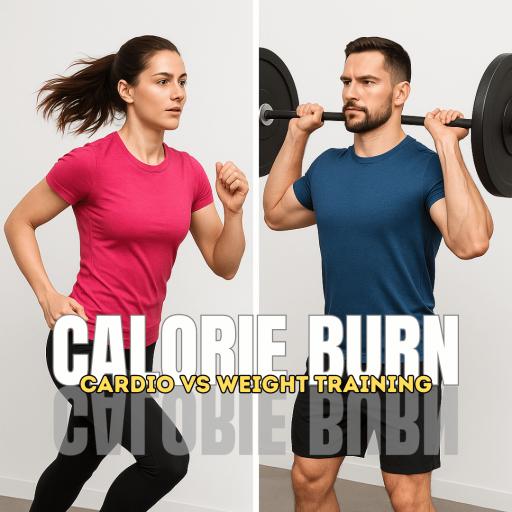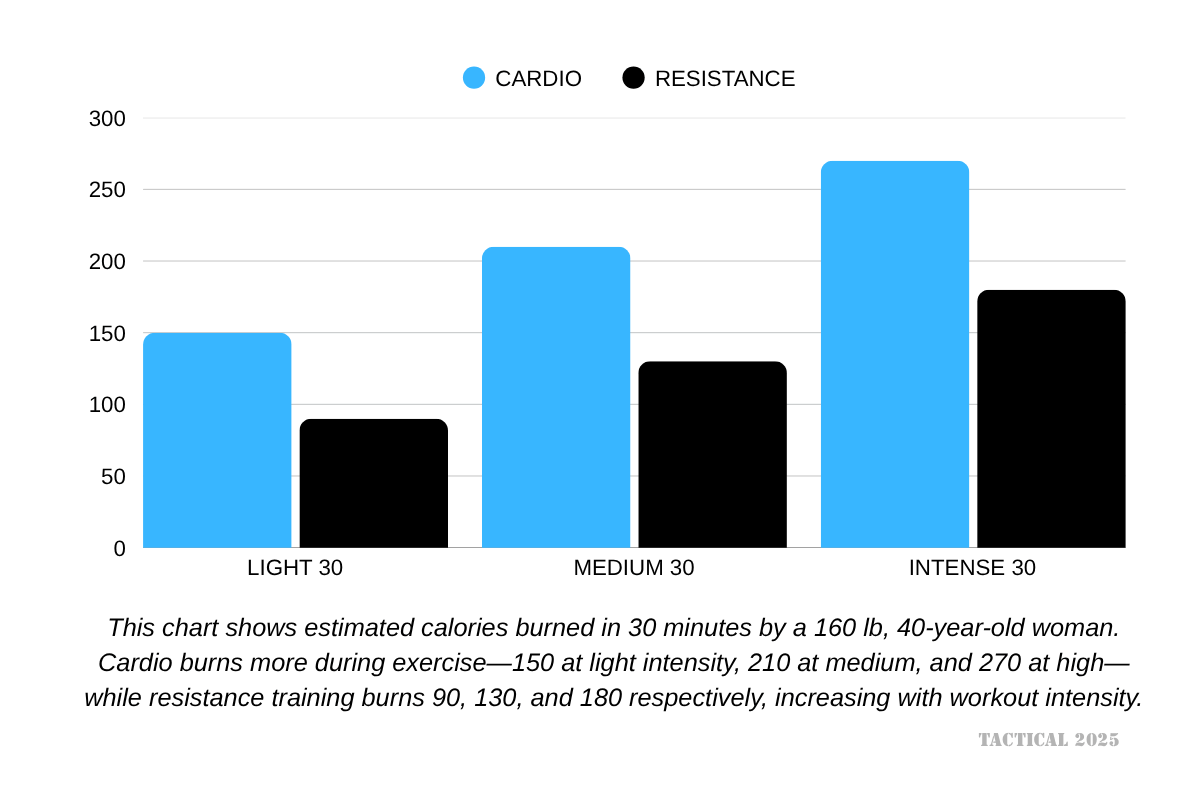Cardio vs. Resistance Training for Calorie Burn
Why Your Workout May Keep Burning Calories Long After It’s Over

When most people think about burning calories, they picture steady-state cardio like running or cycling. These activities have a clear energy demand—your heart rate increases, your breathing gets faster, and your body uses more oxygen. But calorie burn isn’t limited to what happens while you're moving. That’s where resistance training enters the conversation. Both cardio and resistance training use energy, but they do so differently. Cardio burns more calories during the workout itself. Resistance training, while generally lower in immediate calorie expenditure, often burns more over time because of EPOC—a metabolic effect that can keep your body burning fuel for hours after you finish.
Steady-State Cardio: What It Burns
The average person burns roughly 5 to 10 calories per minute during moderate-intensity steady-state cardio like brisk walking, cycling, or light jogging. At higher intensities (e.g. running at 6–7 mph), calorie burn can increase to 12–15 calories per minute depending on your body weight, fitness level, and workout duration.
👉 A 160 lb (72.5 kg) person running at 6 mph for 30 minutes might burn around 350–400 calories.
👉 That same person walking at 3.5 mph would burn closer to 150–180 calories in the same time frame.
The energy comes primarily from aerobic metabolism—your body uses oxygen to convert carbohydrates and fats into usable energy (ATP). The downside? Once the session ends, calorie burn tapers off quickly. Within an hour of finishing, you're back to baseline.
Resistance Training: What It Burns

Resistance workouts generally burn 3 to 8 calories per minute depending on intensity, muscle mass involved, rest periods, and exercise selection. A basic circuit of machines with long rests might only burn 90–120 calories in 30 minutes. A high-intensity, compound-heavy session with minimal rest might burn closer to 180–240 calories in the same time. So on paper, it looks like resistance training burns less. But that’s only part of the story.
Enter EPOC: Excess Post-Exercise Oxygen Consumption
EPOC is the amount of additional oxygen your body consumes after exercise in order to return to its resting state. Think of it as a recovery tax—your body pays in oxygen (and calories) to restore normal breathing, replenish ATP stores, clear lactate, repair muscle tissue, and rebalance hormones. This post-exercise oxygen cost increases your overall calorie burn—sometimes by 6–15% of the total energy expended during your workout. But the type of workout matters.
What Influences EPOC?
✔ Intensity: The higher the intensity, the more EPOC you generate.
✔ Duration: Longer workouts can increase EPOC, but intensity is more impactful.
✔ Type of exercise: Resistance training, especially with compound movements (e.g. squats, deadlifts), creates more muscle damage and metabolic stress—both of which amplify EPOC.
✔ Training status: Trained individuals may recover faster, but still show a meaningful EPOC response from heavy or metabolic training.
How Long Does EPOC Last?

EPOC can last from 1 to 48 hours depending on intensity and the individual’s metabolic efficiency. For typical strength training workouts, elevated calorie burn can persist for up to 24–36 hours, with the first 2–8 hours being the most metabolically active. One study showed that subjects who did a circuit-style resistance workout experienced a 10% increase in resting energy expenditure for up to 38 hours. That could mean an extra 150–200 calories burned even while sitting at your desk the next day.
Comparing Total Calorie Burn
Let’s compare two 45-minute sessions for a 175 lb (79.4 kg) person:
Steady-State Cardio (jogging @ 6 mph)
Workout burn: ~450–500 calories
EPOC: ~30–60 calories
Total: ~480–560 calories
High-Intensity Resistance Training (deadlifts, squats, rows, etc.)
Workout burn: ~225–300 calories
EPOC: ~100–200 calories over 24+ hours
Total: ~325–500 calories
In the short term, cardio has the edge. But resistance training’s post-exercise burn narrows the gap—and over the course of a week or month, it can shift the balance entirely, especially when you factor in muscle preservation and metabolism.
Muscle Mass and Metabolic Rate
Resistance training helps preserve or build lean mass, which burns more calories at rest than fat. While the difference per pound isn’t enormous (roughly 6–10 calories per day per pound), it adds up. Someone who gains 5–10 pounds of lean mass through consistent training could be burning an extra 50–100 calories per day at rest. Cardio alone, especially at high volumes without resistance work, can sometimes decrease lean mass over time—especially during a calorie deficit. This may lower resting metabolic rate, making fat loss and maintenance more difficult.
Training Goals Matter
If your primary goal is to burn calories right now, cardio is efficient and predictable. But if your goal is to improve body composition, metabolic health, and long-term energy balance, resistance training offers benefits beyond the session itself. Combining both modalities is optimal for most people.
For Fat Loss and Body Recomposition
👉 Use cardio for creating a calorie deficit and improving cardiovascular endurance.
👉 Use resistance training to preserve muscle, amplify EPOC, and maintain metabolic rate.
⚡ EPOC from resistance training offers a “slow drip” of extra energy expenditure, even while at rest.
For General Health and Longevity
Both forms of training improve insulin sensitivity, cardiovascular function, and mental health. But resistance training also improves bone density, postural control, and fall prevention, which is especially critical as we age.
For Aging Adults
The EPOC effect, though slightly reduced in older adults, still provides metabolic benefits. Resistance training also combats sarcopenia (age-related muscle loss), making it the more protective choice over time. Including both modalities—walking, cycling, resistance bands, and light weightlifting—is ideal.
The Bottom Line
✔ Steady-state cardio burns more calories during a workout.
✔ Resistance training continues to burn calories after your workout through EPOC.
✔ EPOC is real, measurable, and magnified by high-intensity resistance training.
✔ Long-term results depend on total activity, muscle preservation, and consistency.
✔ The most effective training programs usually include both cardio and resistance components.
If you want to maximize fat loss, protect your metabolism, and build a leaner, more capable body—don’t skip the weights. The calories may keep burning long after the last rep is done.
⏱
| Workout | Calories | Duration |
|---|---|---|
| Light Cardio | 150 | 30 min |
| Heavy Weights | 240 | 30 min |
Updated: August 13, 2025 10:19
Category: Fitness
Keywords: calories weight loss workouts cardio weight lifting resistance training
References
1. Greer, B. K., Sirithienthad, P., Moffatt, R. J., Marcello, R. T., & Panton, L. B. (2015). EPOC comparison between isocaloric bouts of steady‑state aerobic, intermittent aerobic, and resistance training. Research Quarterly for Exercise and Sport, 86(2), 190–195. PMID: 25675374. https://pubmed.ncbi.nlm.nih.gov/25675374/
2. Greer, B. K., O’Brien, J., Hornbuckle, L., & Panton, L. B. (2021). EPOC comparison between resistance training and high‑intensity interval training in aerobically fit women. International Journal of Exercise Science, 14(2), 1027–1035. https://digitalcommons.wku.edu/ijes/vol14/iss2/13
3. Pilon, R., Matos‑Santos, L., Matlez, M. P., Rodrigues, G., Amorim, F., Lattari, E., Farinatti, P., & Monteiro, W. (2024). Effects of Isocaloric Resistance, Aerobic, and Concurrent Exercise on Excess Postexercise Oxygen Consumption in Older Adults. Journal of Strength and Conditioning Research, 38(4), 755–761. PMID: 38513180. https://doi.org/10.1519/JSC.0000000000004683
4. LaForgia, J., Withers, R. T., & Gore, C. J. (2006). Effects of exercise intensity and duration on the excess post‑exercise oxygen consumption. Journal of Sports Sciences, 24(12), 1247–1264. PMID: 17101527. https://doi.org/10.1080/02640410600552064
5. Johnson, H. K., Staibano, V. L. G., Franchini, E., & Hazell, T. J. (2020). Magnitude and duration of EPOC: systematic review and meta‑analysis comparing high‑intensity interval and moderate continuous training. Revista Brasileira de Medicina do Esporte, 29(1), 2021_0005. https://doi.org/10.1590/1517-8692202329012021_0005
Comments
You must log in to post a comment.